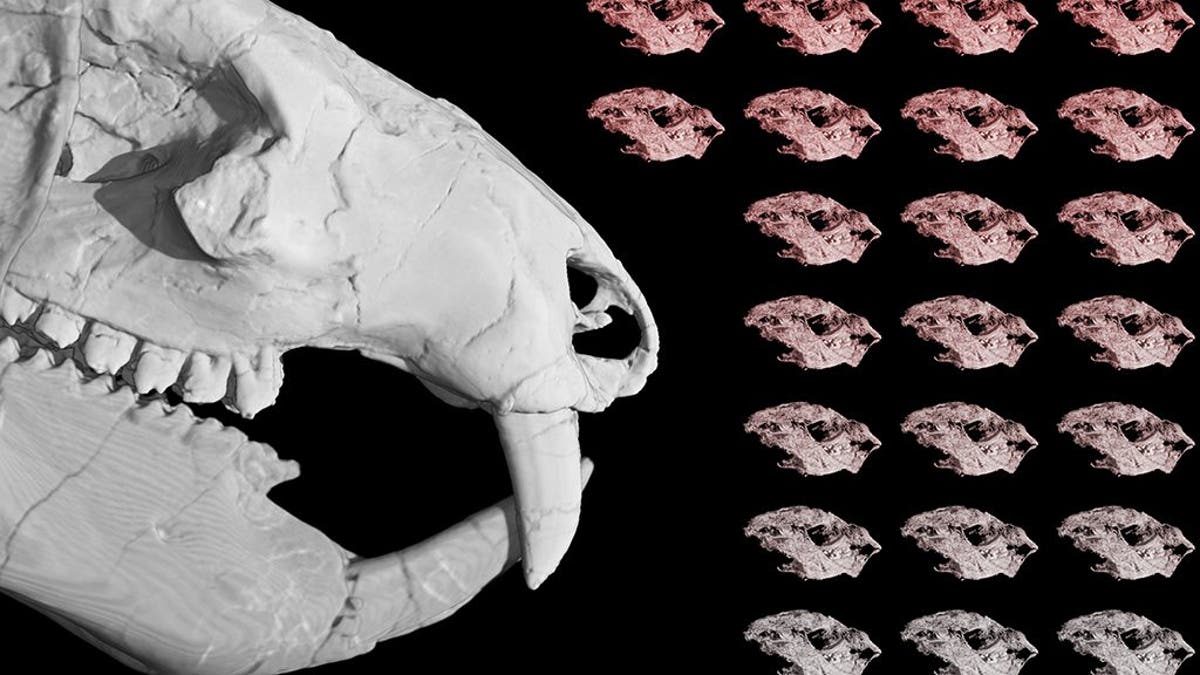
A figure representing the 38 Kayentatherium babies found with an adult specimen. They are the only known fossils of babies from an extinct mammal relative that lived during the Early Jurassic. (Credit: Eva Hoffman / The University of Texas at Austin)
New fossils of an extinct mammal relative and her 38 babies are among the best evidence that a major evolutional development for mammals occurred, allowing them to trade increased reproductive ability for bigger brains.
The discovery is extremely rare because these fossils are the only known babies of a mammal precursor on record, according to researchers at the University of Texas.
The discovery "is a once-in-a-lifetime type discovery that can have a huge impact on how we view mammal biology," Greg Wilson of the University of Washington, told Live Science.
ANCIENT INSCRIPTION DISCOVERY THRILLS ARCHAEOLOGISTS IN ISRAEL
The animal, called the Kayentatherium wellesi, was a cynodont or mammal relative that lived during the Jurassic period, some 185 million years ago. The numerous babies she had were more than twice the average size of any mammal living today, which may indicate that K. wellesi reproduced similarly to a reptile.
While no eggshells were discovered at the site, the study found the babies were likely developing inside eggs or had just hatched when they died.
The babies had very small brains, supporting the notion that as mammals developed, they traded off small brains and big litters for larger brains and smaller litters, the researchers said.
"These babies are from a really important point in the evolutionary tree," the study's lead researcher, Eva Hoffman, said in a statement. "They had a lot of features similar to modern mammals, features that are relevant in understanding mammalian evolution."

(Credit: Eva Hoffman / The University of Texas at Austin)
Discovered more than 18 years ago, the fossils were uncovered in northeastern Arizona by study co-researcher Timothy Rowe, a professor at the University of Texas. Rowe initially believed the chunk of rock he excavated contained only one specimen.
However, the sample became more exceptional when Sebastian Egberts, a former graduate student at the Jackson School, noticed a speck of tooth enamel in the slab in 2009.
"It didn't look like a pointy fish tooth or a small tooth from a primitive reptile," said Egberts, who is now an instructor of anatomy at the Philadelphia College of Osteopathic. "It looked more like a molariform [molar-like] tooth — and that got me very excited."
Micro-computed tomography (CT) scans showed the rock included more than just the mother. It also contained the partial skeletons of the babies of the same species.
Since K. wellesi had a tiny brain and many babies, it also appeared that the step in which mammals traded litter power for brain power had not occurred in the early Jurassic period, the researchers said. It was not until a few million years later did mammals expand their brain size at the expense of their number of offspring.
"Our reproductive biology is such a central component to being mammal," Greg Wilson said. "This fossil gives us a snapshot of the reproductive biology of an animal that was not quite mammalian yet. It gives us a window into the transition from what it means to be reptile to what it means to be mammalian.
